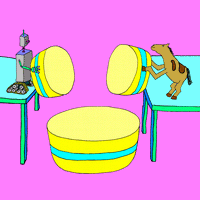By Michael Hartley
This kindergarten addition math game, or addition worksheet, is not a worksheet in the traditional sense. However the kids in your care are sure to love it, because it combines math concepts with their favorite food and a colorful picture. If you download and print it now, you'll see the picture has a horse and a robot, each holding a bowl, with a large bowl in the middle.
Sultanas!
My four-year-old was trained with something like this in his kindergarten. When I drew the pictures on these worksheets, he wanted to play again. So I got some sultanas from the fridge. Melvin really likes sultanas. The kid you want to teach may prefer cornflakes, or mini biscuits, or any other "finger food". Obviously sweets are not such a good idea, and nuts are not generally advised for kids under five.
How many, Melvin?

I put a few sultanas in the robot's bowl, and also in the horse's bowl. Then I asked him, "How many sultanas does the robot have?" He counted them, and gave me the answer.
"One, two, three!"
"What about the horse?"
"Three!"
Then, I told him "now they pour all the sultanas into the big bowl" and swept them down with my hand.
"How many in the big bowl now?"
I was delighted at his answer. He responded without counting, and barely even looking at the bowl.
"Six!"
Of course he got to eat all six sultanas after that, and a big extra handful to boot!
Will this work for your kid?
It certainly should! Here's a suggestion or two for how you could use the worksheets
- Start, of course, by printing out the worksheets. I've provided one in black and white, and another in color. You may like to laminate the paper if you intend to use it a lot, or bookmark this page.
- Tell the child you're going to play a nice game, and sit him or her down.
- Get some cornflakes or sultanas (or whatever your kid likes) and place some in each of the two small bowls. Not too many at first - the number should match the kid's counting ability.
- Ask him or her to count the number in the robot's bowl, and in the horse's bowl. If they have trouble, then show them how to count - point at each cornflake in turn, and count "one, two! two cornflakes! yay!" It helps to be cheerful and enthusiastic. Kids love enthusiasm!
- Then, say "Now they are pouring the cornflakes into the big bowl! Whee! How many are in the big bowl now?"
- At first, the child will have to count them. Knowing, for example, that two and three makes five is something that comes through much repetition.
- When the child gets the right answer, encourage them "That's right! You are so clever! Two cornflakes, and three cornflakes, makes five cornflakes! So clever!!"
- Of course, let them eat the cornflakes after that!
What could go wrong?
A four to six year old will not always sit quietly and obediently through this exercise. However, if it goes smoothly for four or five days in a row, it will be very close to a habit for the child. It's worth enforcing your ground rules for the child from day one.
- Make sure the poor kid is not too hungry when you play the game. Otherwise, they'll likely find it a miserable experience to see so many yummy snacks in front of them but not be allowed to eat it. Expect disobedience and frustration!
- Even when not hungry, some children will try to eat first without counting. Then they'll throw a tantrum when you refuse to let them. Don't give in! Whenever my kid tries that trick, I say "if a game makes you cry, you shouldn't play" and pack it away. Tantrums are not a common part of his repertoire nowadays. It may sound cynical, but this is a fact: just like Pavlov's dog, your kid will learn pretty quickly which of crying or counting gets them cornflakes to crunch!
- Sometimes a child will just look totally baffled, even if they could count perfectly well the day before. I'd recommend leading them "by the hand" through one or two rounds of the game (but fewer rounds than normal) then calling it a day. You don't want the game to be unpleasant for either you or the child.
- If the phone rings, remember - never, never, leave a child unattended with a large box of snacks within easy reach! You may find, when you hang up, that you don't have much playing material left!
When all goes well...
So, I hope this kindergarten addition game helps your kid as much as it helped mine. If all goes well, your child will "just know" what are three and four, or four and five, or one and seven, and so on and on.
If it works well for you and the children in your care, you'll probably also want to get the kindergarten subtraction game that I've explained on another page on this site.
Enjoy!
